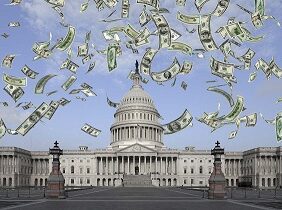It’s near political consensus in Washington that an emergency spending package in response to natural disasters is on the horizon. With Speaker Johnson (R-LA) dismissing calls for Congress to return prior to its scheduled return a week after the election, a supplemental appropriations bill will likely be one of the first items in the post-election lame duck session. Exactly what will be included is up for debate, but the universe of requests is large and growing.
Emergency supplementals are viewed as must-pass bills that often garner broad bipartisan support. Most provisions in these packages are designated an “emergency” under budgeting rules and thus lawmakers are not required to offset the new spending through spending reductions in other programs or revenue increases. The desire to help Americans affected by natural disasters coupled with the “emergency” designation of spending results in disaster supplementals that expand in size and scope often beyond the immediate natural disaster that prompted them.
Below is an accounting of items with a high likelihood of being proposed for a supplemental package in the lame duck session. The Biden Administration has not transmitted to Congress a formal request for assistance. There are items from the administration’s national security needs (10/20/2023) and domestic priorities (10/25/2023) requests that were not included in FY2024 spending bills. In a June 2024 letter to Congress requesting funds to respond to Baltimore’s Key Bridge disaster, the President reiterated these requests, providing updated cost estimates for some. Thus these items are likely to be included in an updated administration request. In addition to previously requested but unfunded items, below are known legislative priorities of members of Congress, and preliminary estimates of losses from Hurricanes Helene and Milton that are likely to be covered by taxpayers. Damage estimates for areas affected by Hurricanes Helene and Milton are still preliminary and thus could grow substantially. The following items should be viewed as a rough guide of the possible size of the emergency supplemental.
Natural Disaster requests (most likely to be included)
- FEMA’s Disaster Relief Fund (DRF)
- October 2023 administration supplemental requests projected a $9,000,000,000 shortfall for FY2024
- Congressional Proposals
- R. 9905 – Reps. Moskowitz (D-FL), Luna (R-Fl), and Williams (D-GA), introduced 10/1/24 = $10,000,000,000
- Rubio (R-FL), Scott (R-FL), Cassidy (R-LA), Cornyn (R-TX), Scott (R-SC) propose $20,000,000,000 emergency appropriation.
- Likely Supplemental Amount = $20-30 billion
- Small Business Administration – Disaster Loans Program Account
- October 2023 administration supplemental requests included $127,000,000 to respond to Hurricane Idalia and the Maui wildfires
- Congressional Proposals
- RELIEF Act – Sens. Tillis (R-NC), Budd (R-NC), Tim Scott (R-SC), Cassidy (R-LA), and Rick Scott (R-FL), drafted 10/29/24 = $550,000,000
- R. 9946 – Rep. Moskowitz (D-FL), introduced 10/8/24 = $8,000,000,000
- Likely Supplemental Amount = $550 million to $1 billion
- Community Development Block Grant (CDBG)
- October 2023 administration supplemental requests included $2.8 billion, with another $700 million requested in June 2024 = $3.5 billion
- Congressional Proposals
- R. 9905 – Reps. Moskowitz (D-FL), Luna (R-Fl), and Williams (D-GA), introduced 10/1/24 = $5,000,000,000 specific to disaster relief for Hurricane Helene.
- Likely Supplemental amount = $5-10 billion
- Department of Transportation – Emergency Relief Program
- October 2023 administration supplemental requests included $634 million, with another $3.1 billion requested in June 2024 = $3.7 billion
- Estimate from Hurricanes Helene and Milton = TBD
- Likely Supplemental amount = $5 billion+
- October 2023 administration supplemental requests included $634 million, with another $3.1 billion requested in June 2024 = $3.7 billion
- Emergency Farm Income Subsidies
- 2023 Losses
- October 2023 administration supplemental requests included $2.833 billion for crop and livestock losses from natural disasters that occurred in calendar year 2023.
- R.9889 – Rep. Valadao (R-CA) and 11 original co-sponsors, introduced 9/27/2024 = $14 billion for losses in calendar year 2023.
- 2024 Losses
- Estimates of $3-6.5 billion for Georgia.
- Florida Agriculture Commissioner estimates $1.5-2.5 billion in agriculture losses (10/17/24).
- Federally subsidized crop insurance, USDA disaster programs, and private insurance will cover some of these losses.
- FARM Act of 2024 – Rep. Kelly (R-MS) and 48 co-sponsors, introduced 10/25/2024. Directs the Secretary of Agriculture to use his Commodity Credit Corporation (CCC) spending authority to assist certain producers. This would be Mandatory funding, thus not appropriated.
- Likely Supplemental amount = $15-20 billion + additional Mandatory funds.
- 2023 Losses
- Department of Defense – Pre-Helene disasters
- $3.5 billion to repair facilities harmed by Typhoon Mawar in Guam; Hurricanes Ian, Nicole, and Idalia in Florida; and severe storms in Tennessee.
- Additional funds for Fall 2024 hurricanes = TBD
- Likely Supplemental amount = $4 billion+
- $3.5 billion to repair facilities harmed by Typhoon Mawar in Guam; Hurricanes Ian, Nicole, and Idalia in Florida; and severe storms in Tennessee.
- Miscellaneous Federal agency costs
- October 2023 administration supplemental requests included funds for numerous other agencies. These unfunded requests totaled $4 billion.
- Additional agency requests for 2024 disasters = TBD
- Likely Supplemental amount = $4 billion minimum
- October 2023 administration supplemental requests included funds for numerous other agencies. These unfunded requests totaled $4 billion.
Total Natural Disaster supplemental spending request = $50 billion to $65 billion+
There are numerous other spending items that lawmakers have sought to exclude from discretionary spending caps using an emergency designation. These include many non-natural disaster related items from the administration’s October 2023 supplemental requests. Many of these items, such as funds for the Childcare Stabilization Fund, currently lack bipartisan support. Other items, such as portions of funds in various Defense accounts, are more likely to be included in a final FY2025 appropriations package, or as spending anomalies in a Continuing Resolution. Finally, the more adamant Congressional Leadership and lawmakers are that a supplemental be focused on response to natural disasters, the less likely spending that lacks a clear nexus to natural disasters will be included.
- $21.5 billion in Defense accounts designated “emergency” by Senate Appropriators
- $16 billion to extend pandemic-related Childcare Stabilization Fund subsidies
- $6 billion in Border Security funding
- $6 billion for the Affordable Connectivity Fund to provide to provide free or discounted internet
- $2.2 billion for Department of Energy uranium enrichment programs
- Other spending items, included in this spreadsheet
A supplemental spending package is viewed as one of the few must-pass items for the lame duck Congress. Another must is either finalizing the regular FY2025 appropriations or extending the current continuing resolution beyond its December 20 expiration. There is no guarantee any of the spending requests, either those already made or those forthcoming, will make it into a final spending package in the current 118th Congress. But the history of disaster supplementals show the universe of requests will grow in size and scope the longer a package is debated.











Get Social